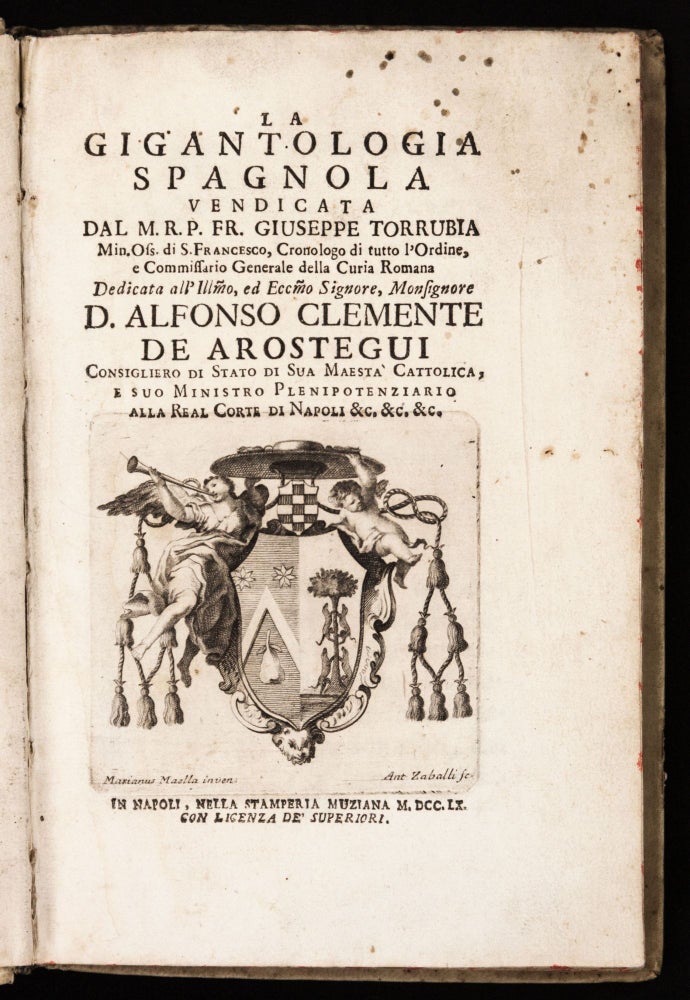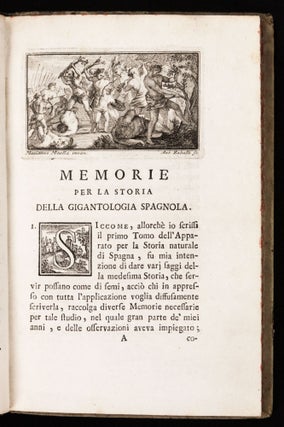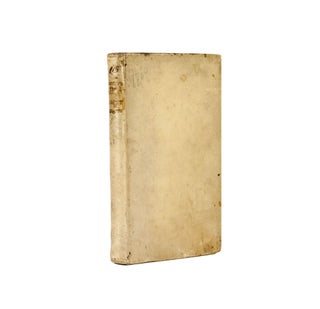La gigantologia spagnola.
8vo. [20.3 x 13.5 cm], (10) ff., 150 pp., with engraved arms on title and a figural engraved headpiece, both executed by Antonio Zaballi (1738-85) after designs by Mariano Salvador Maella (1739-1819), woodcut initials, woodcut headpiece and tailpiece. Bound in contemporary vellum, title gold stamped on spine, red mottled edges. Shelf-mark in ink on spine, minor rubbing and staining to spine and boards. Marginal spotting to title, the occasional minor stain elsewhere, a few contemporary annotations. Rare first and only complete edition of an early work on fossils in the Americas by “one of the founders of paleontology” (Mancini, p. 131), the Franciscan historian and naturalist José Torrubia (1698-1761). La gigantologia Spagnola is a much-expanded version, composed in Italian, of an essay which first appeared in Spanish in Torrubia’s Aparato para la historia natural Española (1754). An early proponent of the idea that fossils were of organic origin, and not spontaneous ‘games of nature,’ Torrubia here examines recent discoveries of large fossil specimens in the Americas (later understood to be mastodons and the like) against various legends (Native American, classical, and Biblical) about races of now-extinct antediluvian and postdiluvian giants. La gigantologia Spagnola – treating as it does recent developments both in paleontology and in Native American studies (Mesoamerican glyphs, native chronologies, etc., from Mexico to Patagonia) – is thus unusual for participating at once in two of the early modern Europe’s most transformative conceptual moments: a reckoning with the existence of other cultures in the New World and the development of a notion of ‘deep time’ pushing natural chronology beyond that defined by theologians. Torrubia updated his work as a riposte to detractors of his original essay (he reproduces an anonymous critique and his own counter-critique), and apparently did so with some success, as the La gigantologia Spagnola still preserved some currency in the fast developing field of paleontology into the 19th century, when the renowned naturalist George Cuvier (1769-1832) recommended that paleontological scholars should consult the book for Aztec and Inca traditions about the bones of giants, noting that the cusped teeth of mastodons resemble human teeth, which perhaps led Native people to think the fossils belonged to a lost race of outsized humans (A. Mayor, p. 94). The finely printed La gigantologia Spagnola is illustrated with an engraving of the arms of Alfonso Clemente de Aróstegui (1698-1774), the work’s dedicatee, and with a curious engraved headpiece showing a melee of giants and men locked in mortal combat. Both engravings were executed by Antonio Zaballi (1738-85) after designs by Mariano Salvador Maella (1739-1819). Maella, at the time young artist working in Rome, later worked in Spain where he gained much esteem as a portrait painter and a painter of frescos, eventually being promoted as primary painter to the Spanish court alongside Francisco Goya (1746-1828). José Torrubia led an eventful life and not only in terms of his scholarship. “Born in 1698 in Granada, he joined the Franciscans in his teens, voyaging to the Philippines in 1721, where he remained for more than a decade before returning to Spain in 1733. In 1745 he returned to New Spain for a period but was accused of serious misconduct [profligate spending] by other Franciscans and was ordered to return to the Philippines to answer the charges. Instead, Torrubia resisted this order by attempting to travel to Spain to face the accusations there, first boarding a French vessel bound for New Orleans and then making his way to Havana – but was apprehended in the latter city and imprisoned in Morro Castle. He was able to establish his innocence and eventually become the Franciscans’ official historian in Rome. Torrubia was also a leading naturalist … [and] this work came to fruition during his many years in Paris in the scientific circles of the Jardin du Roi and in Rome, but began in the Philippines in the 1720s, when his position as a procurator required him to traverse the archipelago on foot, giving the young naturalist many opportunities to collect samples and make scientific observations” (J. M. Mancini, pp. 130-31). OCLC locates U.S. examples at Brown, Minnesota, St. Bonaventure, Florida State, and Kansas Medical. * F. Pelayo, “El Orden Natural y los Gigantes la Gigantologia Spagnola Vendicata (1760) de José Torrubia,” Archivo teológico granadino, no 65, (2002), pp. 129-186; A. Mayor, Fossil Legends of the First Americans; J. M. Mancini, Art and War in the Pacific World; M. Julivert, Una historia de la geologia en España, p. 38.
Sold



